Academic Essay Writing for Postgraduates
(Independent Study)
SUPPLEMENTARY MATERIALS
Tony Lynch and Kenneth Anderson
© English Language Teaching Centre
University of Edinburgh 2014
page 1
1 SAMPLE TRANSPORT ESSAYS
2 ESSAY INTRODUCTIONS
3 ACADEMIC USE OF PRONOUNS
4 THE CONTENTS PAGE
5 CITATION TECHNIQUES
6 PLAGIARISM
7 ABSTRACTS
8 NOUN CHAINS
9 CRITICISM IN ACADEMIC CULTURES
10 INTERPRETING DATA
11 DISCUSSING YOUR OWN DATA
12 BIBLIOGRAPHIC PRESENTATION
Commentary on the Study Tasks
Sample Internet essay 1 (2004)
Sample Internet essay 2 (2005)
Sample Internet essay 2 (2009)
5
7
8
10
12
13
14
15
16
17
19
22
25
28
31
�
Academic Essay Writing for Postgraduates
Supplementary Materials
Supplement 1
SAMPLE TRANSPORT ESSAYS
Here are two students’ essays on transport policy, for you to evaluate. When you have
had a chance to read and think about them, you can compare your evaluation with
ours (in the Commentary on the Study Tasks on pages 22-24 of these
Supplementary Materials).
Essay 1
It has been pointed out that road transport policies in the developing world help the rich at the
expense of the poor. How far is this also true in developed countries?
Road transport is regarded as an integral and necessary element of infrastructure in all parts
of the world. But its development is inevitably biased against the poorer sections of society,
whether in the developed or developing countries.
In considering the problems associated with the growth of road transport I will concentrate on
the car, rather than on all petrol-driven road vehicles. This restriction is justifiable if we bear in
mind that most road traffic is made up of cars. Jenkins (1994), for example, reported that they
accounted for 76% of traffic volume in the USA and Italy, and over 80% in the UK. The ratio of
cars to commercial vehicles is certainly lower in developing counties, but the car is still
dominant; UN figures for 1993 indicate that the private/commercial vehicle ratio ranged from
5:1 in Ethiopia to 3:2 in Botswana and Ecuador. So the car is the main element in road
transport, irrespective of a country’s level of economic development.
There seem to be four areas in which (relatively) poor communities and individuals are
disadvantaged by the growth of road transport networks: social, geographical, environmental
and political. I will discuss these in turn.
The social bias against the poor is found at the root of things: put simply, policy makers
assume that most people are car owners. This socially weighted assumption has little basis in
reality. Even in developed countries, car-owning households are in the minority. According to
Jenkins (1994), figures from 1992 showed that 56% of British households were without a car;
and that figure rises as high as 90% in developing countries (Eher 1995). Moreover, it should
not be forgotten that not all those people who have a car in their family actually have access
to it at any one time. Eher says that ‘six or seven out of every ten in Britain are dependent on
other means of transport’ (Eher 1995: 163). So the in-built bias of planning projects towards
car drivers, in terms of road building, the provision of parking spaces and the location of out-
of-town shopping centres, is a bias against the car-less majority, which is predominantly the
poor.
1
�
Academic Essay Writing for Postgraduates
Supplementary Materials
The second issue appears at first sight to be geographical, but in fact it is closely linked with
the distribution of wealth. It is the fact that urban road developments tend to disrupt the poorer
city districts rather than the areas where the better-off live. In order to make the commercial
centres more accessible to cars, inner city land (cheaper, because it is residentially less
desirable) is bought up, housing is destroyed and motorways are constructed. The people
living in these areas may protest against such schemes, but their campaigns are rarely
successful. In October 1995 the residents of Hackville and Sawston, two working class areas
of Seattle, organised a campaign of local resistance. Yet it seems that the protesters found
little sympathy from the other Settle residents: “there was no support for the campaign from
those not directly affected by the freeway development” (Schreik 1995).
The third point is environmental. Even the poorer residents whose homes survive inner city
road plans then suffer the physical side-effects, in the form of pollution. Noise pollution comes
as their houses are constantly shaken by the vibration and noise from passing traffic.
Chemical pollution - especially from carbon monoxide and lead - in vehicle exhaust fumes
represents a nuisance in the form of dirt but also a serious danger to the health and mental
development of young children living in the affected areas.
The final bias against the poor is political. In today’s society, transport is inseparably linked
with business and industrial interests. Against the power of groups such as construction
companies, car manufacturers and the petro-chemical industry, there is little chance for
opposition from the inner city residents (who include a high proportion of pensioners who
cannot afford to move away to the suburbs). Even the public transport systems that are
intended to help the poor are often run-down and insufficiently subsidized.
To sum up, it is the poorest communities that suffer most, in various ways, from policies that
encourage road building. This is as true in developed countries as in the developing. I believe
it is important that governments should take account of the needs of less well-off citizens, by
adopting transport policies that restrict - rather than extend - the use of the private car. As
things are, the minority benefits from road transport development at the expense of the
majority.
(746 words)
References
Eher M. (1995) ‘Taken for a ride?’. Traffic Update 23/2: 150-172.
Jenkins C. (1994) ‘Conflict of interests in road policy’. Urban Planning Review 16/2: 40-64.
Schreik W. (1995) ‘Seattle’s road plans run into trouble’. West Coast Investigator. October 17, 1995.
2
�
Academic Essay Writing for Postgraduates
Supplementary Materials
Essay 2
It has been pointed out that road transport policies in the developing world
help the rich at the expense of the poor. How far is this also true in developed
countries?
In every country, developed or developing, very few people are prepared to
walk. Walking as a human activity has been replaced by various forms of
transport, especially the car. Poorer people save to buy a car when they can;
the rich have more than one. The number of cars has, in the space of two
decades, grown to 170 million, compared with 36 million commercial vehicles
- a ratio of approximately 5:1. Over the same period, the percentage increase
for cars varied from 130% in the USA to 540% in Sweden (United Nations
statistics, quoted by Jenkins 1994).
With this increase in the number of private cars in the wealthier North, there is
a growing demand for a high-quality and durable road network. The
consequence is that the number of people using commercial vehicles has
declined, which makes it difficult for the commercial vehicle owners to
maintain them. As a result, there has been a cut in the number of services
provided and an increase in fares for the public.
The number of cars largely determines the width of the new roads (Jenkins
1994), and we now commonly see six-lane elevated highways such as the
one described as “carving its way through the poorer parts of Seattle” (Schreik
1995). The construction of such highways takes place on the basis of a
general agreement that the road should take a route which produces the
maximum benefit at the minimum cost. This means that “roads tend to be built
through deprived areas, where property is cheapest” (Jenkins 1994: 51).
The proportion of the population that owns a car is relatively high in the
developed world, where wealth is more equally distributed. In the developing
world, on the other hand, car ownership patterns reflect wider inequalities: “in
3
�
Academic Essay Writing for Postgraduates
Supplementary Materials
Sao Paulo, Brazil, there are more second and third cars owned by rich
families than there are cars owned by all the poorer half of the city” (Eher
1995: 153).
The use of the highways built with public funds is often restricted to cars and
so to car owners. The poor, who are unable to buy their own car, have to bear
the consequences. Poor families are deprived not only of a place to live but of
the means to feed themselves. In addition, there is the problem of pollution:
forced to walk to work (by rising public transport fares) the poor have to
breathe air contaminated by traffic fumes.
It can be seen, then, that road building mostly directly benefits the rich in the
Third World, while it is the poor that pay the costs. With this in mind, it seems
that “the construction of motorways is a modern parable, using public funds to
make life easier for the rich and harder for the poor” (Eher 1995: 171). These
policies carry a serious risk: the differences in effect on the better-off and
worse-off in a developing economy could become a cause of dispute and
conflict. It is vital that the interests of the majority are not ignored.
(502 words)
References
Eher M. (1995) ‘Taken for a ride?’. Traffic Update 23/2: 150-172.
Jenkins C. (1994) ‘Conflict of interests in road policy’. Urban Planning Review 16/2: 40-64.
Schreik W. (1995) ‘Seattle’s road plans run into trouble’. West Coast Investigator. October 17, 1995.
Study Task 1
Which of the essays do you think is better, and why?
4
�
Academic Essay Writing for Postgraduates
Supplementary Materials
Supplement 2
ESSAY INTRODUCTIONS
Study task 2
Below are three students’ introductions to the same essay, with the title Summarise the main
advantages and disadvantages of using video equipment and materials in the language
classroom. Which do you think is (1) the most effective, and (2) the least effective?
Introduction 1
Video film has a high potential as a valid medium in the foreign language classroom.
But as with any other teaching materials and media, the benefits of video as a
teaching tool depend very much on how it is put to use in the foreign language
classroom.
Unfortunately many teachers still only make sure that it is used. Most teachers are
not very creative in their use of video and in many classrooms it is not more than a
‘Friday afternoon treat’. However, video can definitely be put to more functions than
that. The following will look at the disadvantages and advantages of using video in
the classroom.
Introduction 2
Video equipment and materials have come to play an increasingly prominent role in
the L2 classroom over the last twenty years. Thus there has been a great increase in
the number of ELT materials developed as an aid to language teaching. Likewise,
some L2 teachers prefer to use ‘authentic’ TV materials. In any case, the use of
video materials seems to be widespread in the L2 classroom, mainly due to its
advantages. However, it also presents some limitations. Let’s outline its main
advantages and disadvantages.
5
�
Academic Essay Writing for Postgraduates
Supplementary Materials
Introduction 3
The 20th century is the era of technology. In the Western world, whatever activity we
embark on and however simple it may be, we are bound to use technology.
Nowadays almost everybody knows what a radio is, what a telephone is, what a TV
set is. These are widespread technologies that need almost no explanation to
anybody because they have existed for most of our century and because they are
simple to use. On the other hand there are other technologies that, although already
familiar to most people, require more explanation of their basic use and have not
acquired the level of simplicity of the other previously mentioned technologies
because they are more recent and also more complex. Video belongs to these
technologies. Having appeared in the 70s, video is now present in a large number of
households. Language schools are also benefiting from its advantages.
Nevertheless, as happens with all technologies, they can be used adequately and
inadequately. Video is no exception. This is why I am now going to analyse its
advantages and disadvantages in the language classroom.
6
�
Academic Essay Writing for Postgraduates
Supplementary Materials
Supplement 3
ACADEMIC USE OF PRONOUNS
You may have noticed that in some of those extracts used in this course, the writer has
used the first person singular, ‘I’. This is increasingly common, but not in all
academic fields; it is the norm in many humanities and social science subjects, for
example, but much less so in science, engineering or medicine.
One alternative is to use ‘we’ instead of ‘I’. The disadvantage of doing that is that it
can be unclear precisely who is meant by ‘we’, because it can refer to any of the
following:
the present writer (= ‘I’)
all the authors of a collaborative paper
all rational adults
the community of specialists in the field
etc.
So one advantage of ‘I’ is that it enables you to show clearly which ideas are your
own.
The very formal expression ‘the present writer/author’ is now extremely rare in
British writing.
Study Task 3
Look at the Introduction to an article in your special field.
Is it by a single author? If so, has he/she used ‘I’, ‘we’, or the impersonal passive?
If you are not sure whether you can use ‘I’ in your essays and projects, ask for advice from
one of your degree course tutors.
7
�
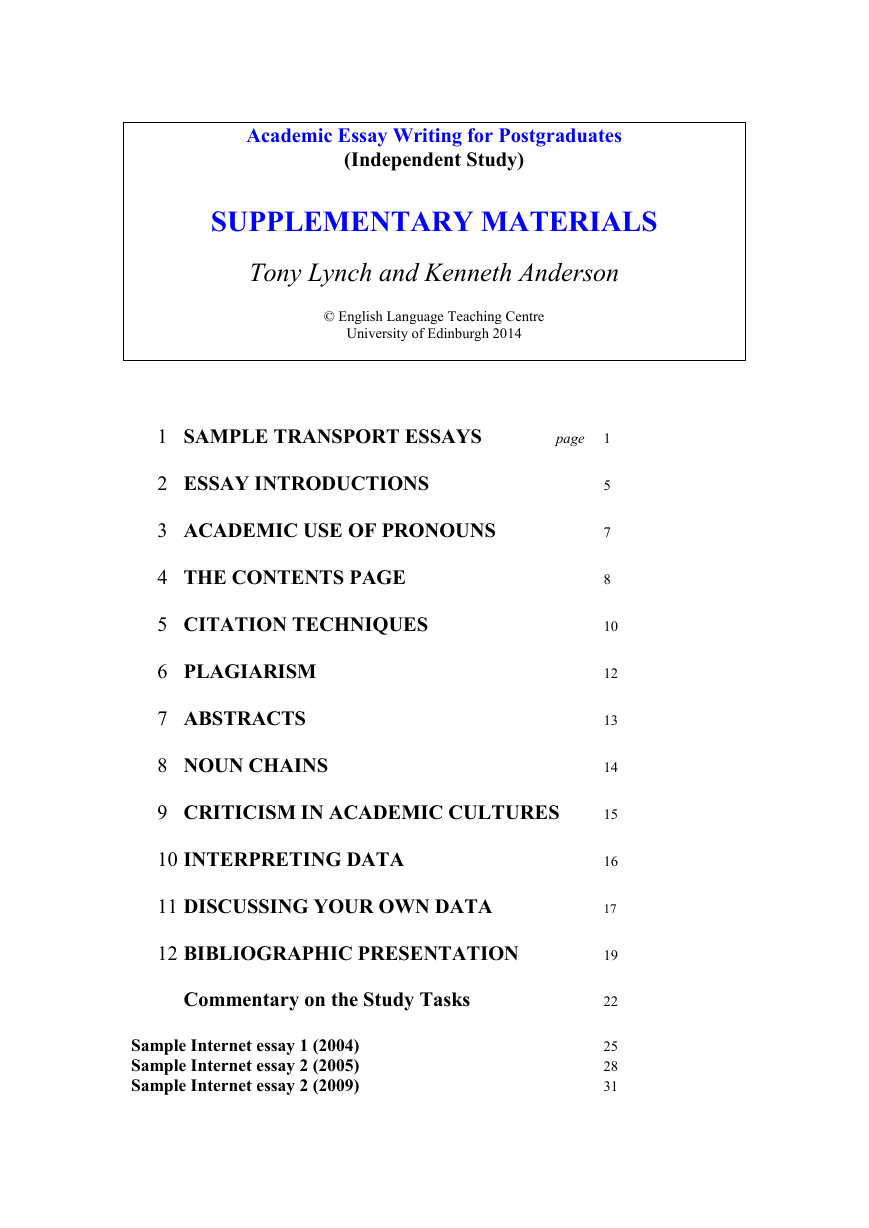
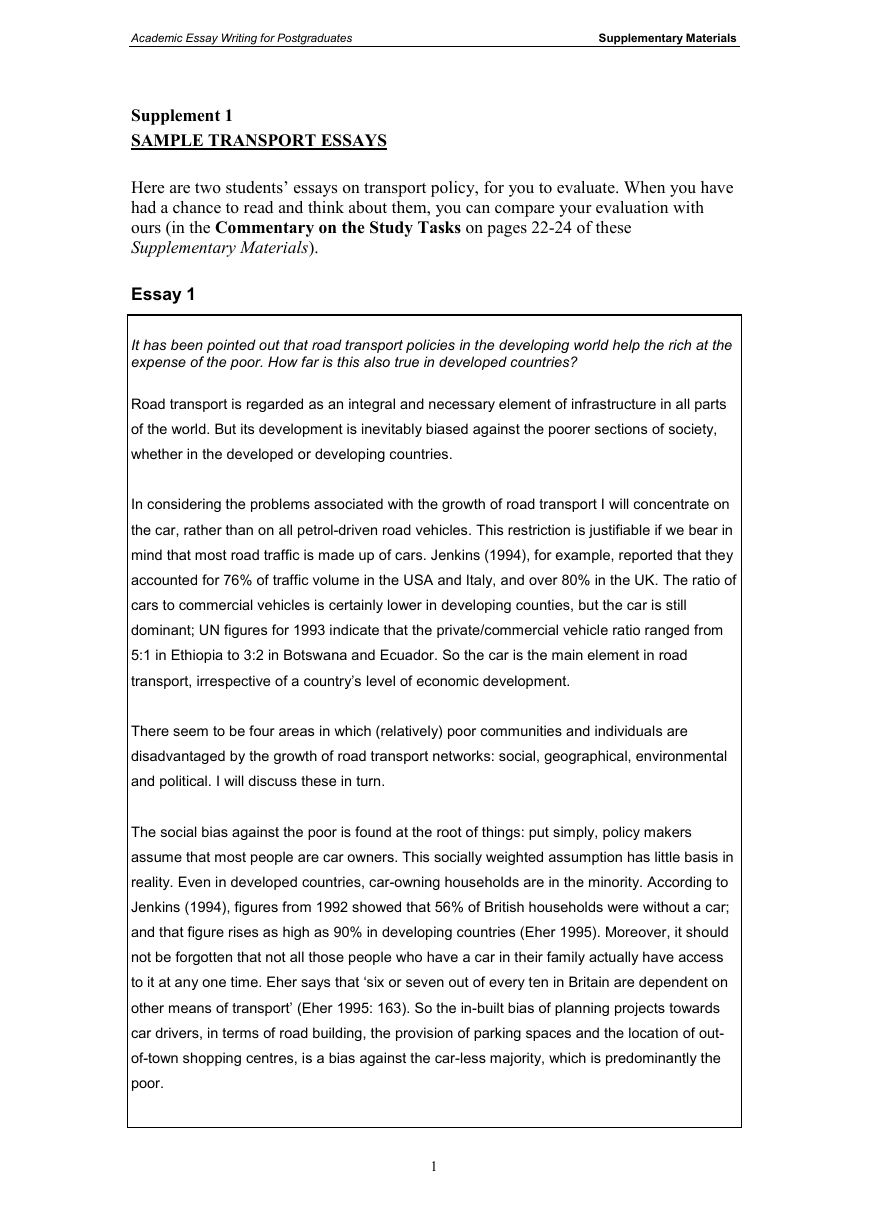
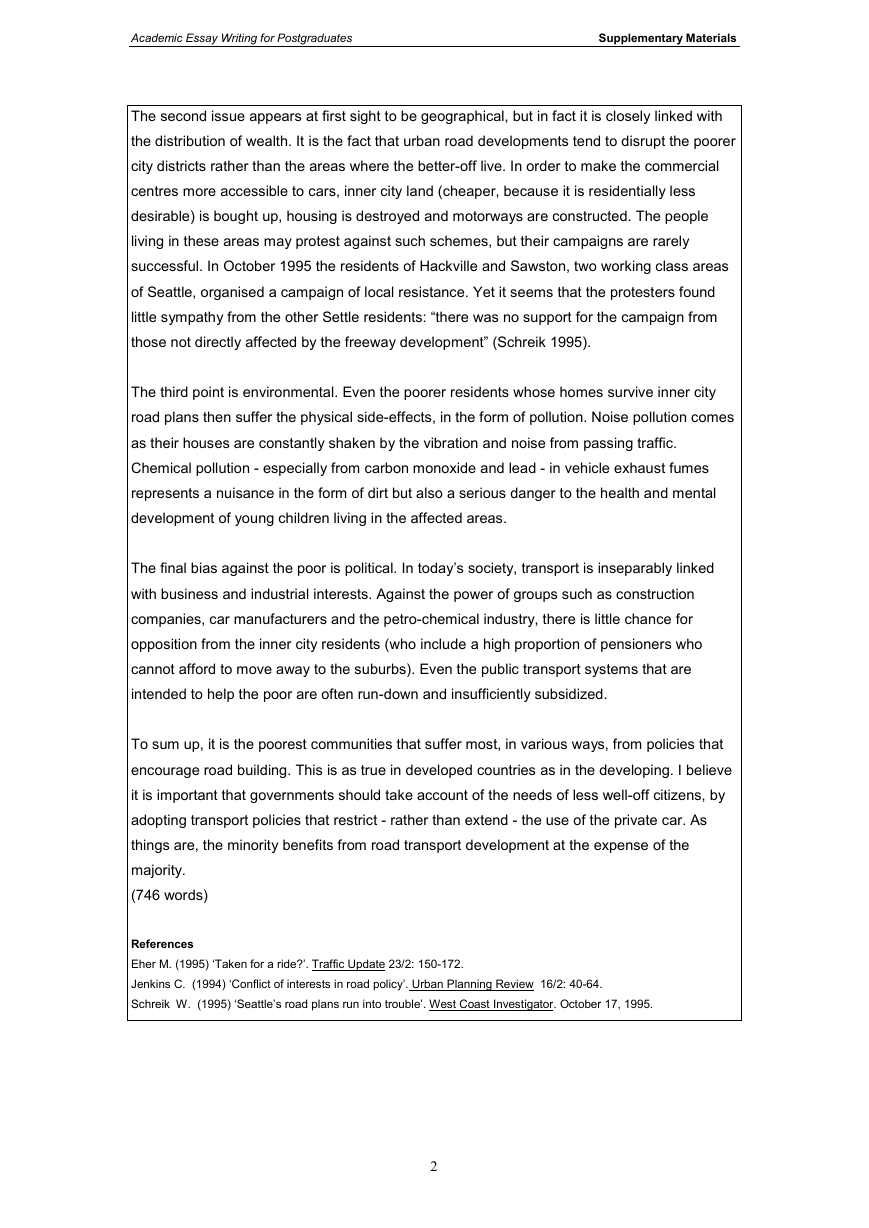

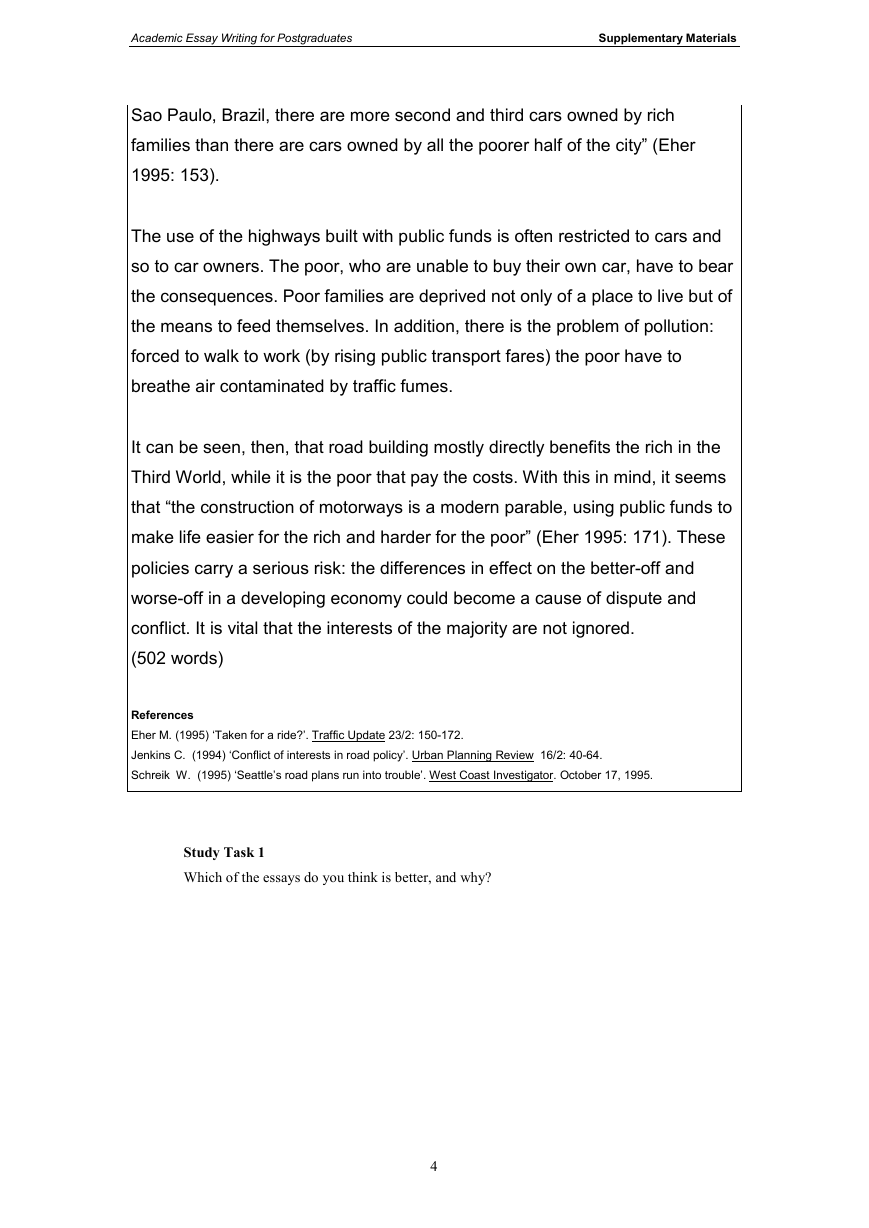


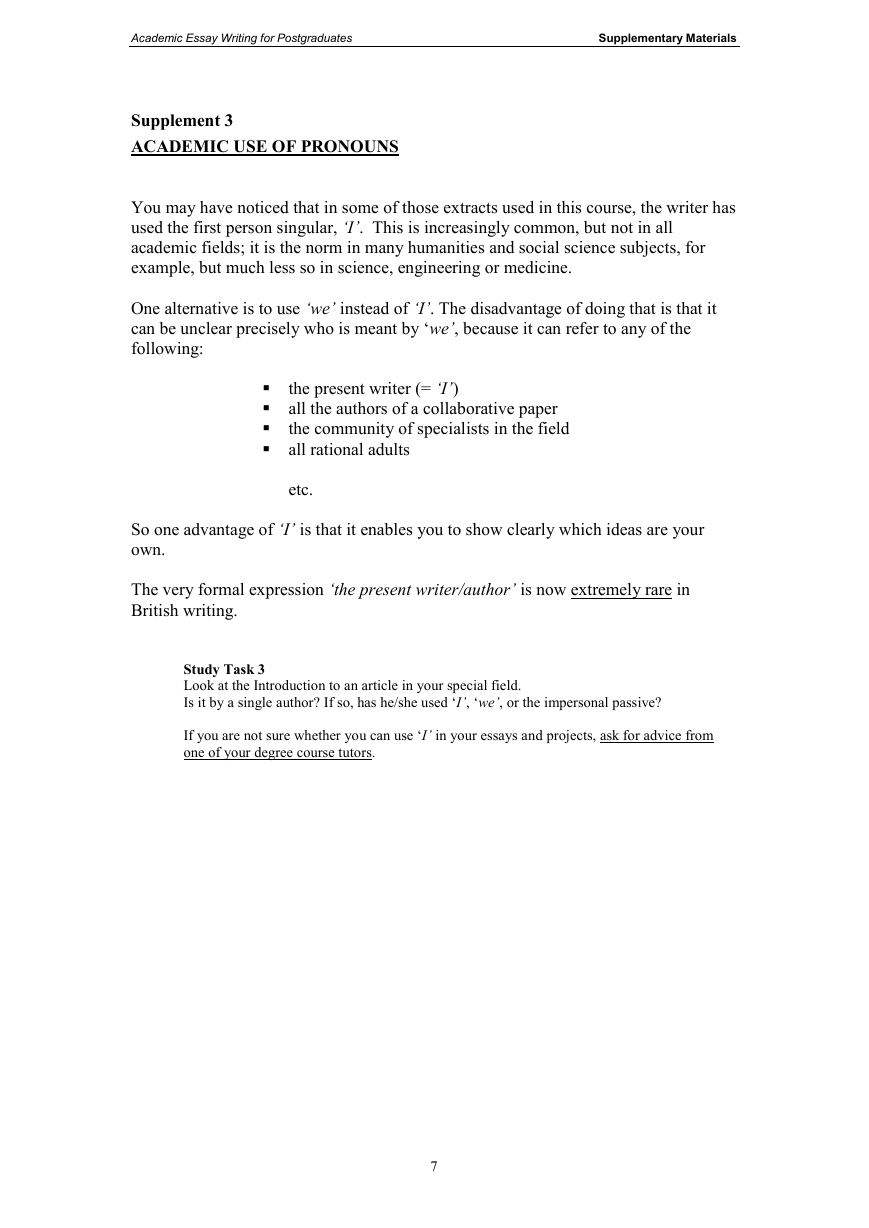








 2023年江西萍乡中考道德与法治真题及答案.doc
2023年江西萍乡中考道德与法治真题及答案.doc 2012年重庆南川中考生物真题及答案.doc
2012年重庆南川中考生物真题及答案.doc 2013年江西师范大学地理学综合及文艺理论基础考研真题.doc
2013年江西师范大学地理学综合及文艺理论基础考研真题.doc 2020年四川甘孜小升初语文真题及答案I卷.doc
2020年四川甘孜小升初语文真题及答案I卷.doc 2020年注册岩土工程师专业基础考试真题及答案.doc
2020年注册岩土工程师专业基础考试真题及答案.doc 2023-2024学年福建省厦门市九年级上学期数学月考试题及答案.doc
2023-2024学年福建省厦门市九年级上学期数学月考试题及答案.doc 2021-2022学年辽宁省沈阳市大东区九年级上学期语文期末试题及答案.doc
2021-2022学年辽宁省沈阳市大东区九年级上学期语文期末试题及答案.doc 2022-2023学年北京东城区初三第一学期物理期末试卷及答案.doc
2022-2023学年北京东城区初三第一学期物理期末试卷及答案.doc 2018上半年江西教师资格初中地理学科知识与教学能力真题及答案.doc
2018上半年江西教师资格初中地理学科知识与教学能力真题及答案.doc 2012年河北国家公务员申论考试真题及答案-省级.doc
2012年河北国家公务员申论考试真题及答案-省级.doc 2020-2021学年江苏省扬州市江都区邵樊片九年级上学期数学第一次质量检测试题及答案.doc
2020-2021学年江苏省扬州市江都区邵樊片九年级上学期数学第一次质量检测试题及答案.doc 2022下半年黑龙江教师资格证中学综合素质真题及答案.doc
2022下半年黑龙江教师资格证中学综合素质真题及答案.doc